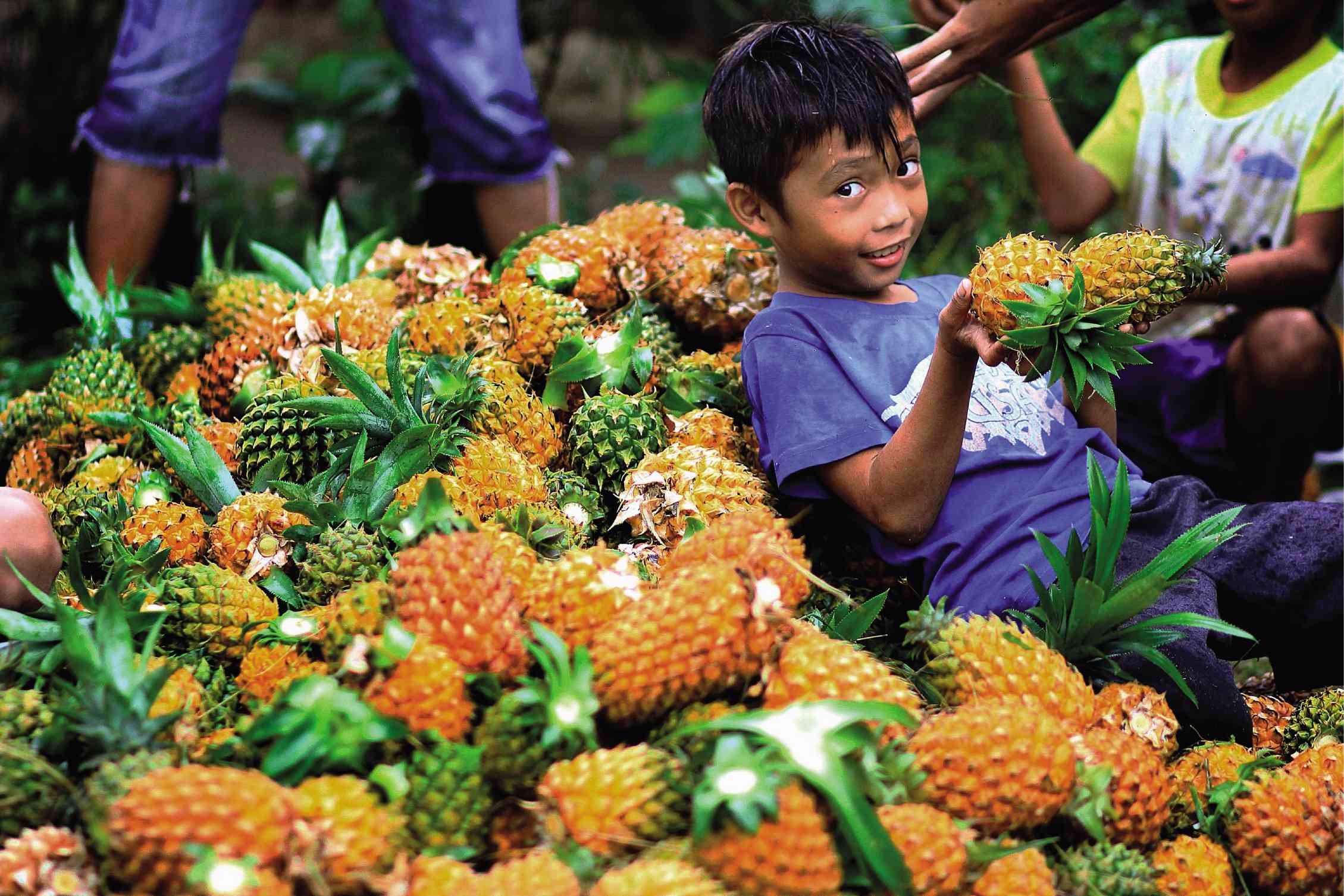
DAET, Camarines Norte—Heaps of the last of ripe Formosa pineapples—the rejects of the season—sat waiting for buyers on farmer Winnie Palero’s yard at the Gawad Kalinga community as it rained gently in this provincial capital for the first time this month.
Like a picturesque depiction of growing up on a farm, Palero’s children ran around the piles of pineapples as Daet was just settling down after the frenzy brought about by the 10-day Pinyasan Festival that ended June 24.
Palero, 44, said she and her husband Demetrio, 45, were able to produce some 13,000 pineapple heads on their one-hectare land at the Gawad Kalinga Pinyasan Village in Barangay Bibirao, Daet.
Those on her front yard, which pineapple growers like her called “butterballs” due to their small size, were leftovers.
Their community of about 200 households is the primary producer of Formosa pineapples in Daet, which supplied the bulk of the more than 1,000 pineapples given out for free and cooked into various food products at the Pinyasan Festival, according to Daet Mayor Tito S. Sarion.
The Pinyasan Festival, which started in 1993, was conceptualized by Sarion during his second term as Daet town councilor.
The festival was known as the Pineapple Festival during its first few years before it was renamed Pinyasan in 2003 to give it a more local touch, said Sarion.
Sarion, who planted and grew pineapples himself with his 14 siblings and farmer-parents during his youth, said the festival was meant to highlight the importance of the Formosa pineapple variety on the lives of the locals, particularly the poor and the Aeta tribe, locally known as “Kabihug.”
He said his inspiration was the colorful headdresses he saw at festivals, which he thought would best depict the beauty of pineapples and the unique tune and rhythm of the Kabihug’s tribal music.
Cut above other varieties
“Aside from its unique sweetness that puts it above other pineapple varieties in the Philippines, you can do so much with the pineapple,” Sarion said.
He said Daet was expanding its campaign of rebranding the Formosa pineapple as the “Queen Pineapple of the Philippines” to further meld it with the identity of the people of Daet and Camarines Norte.
His own home, which he is planning to open as a Pineapple House Museum to tourists on his 48th birthday on Aug. 30, has more than 300 items with pineapple motifs, ranging from display knickknacks, plates, lanterns, ceiling accents, stuffed toys and kitchen utensils.
The 22-year-old festival has developed and expanded from its beginnings as a simple town event into a provincial festival, featuring a beauty pageant, street dancing competition, float competition, pineapple peeling and cooking contests scheduled during the last two weeks of June.
Free ice cream
Whole pineapples and pineapple-based food like gallons upon gallons of ice cream were given out for free during the entire duration of Pinyasan as one of its unique attractions, Sarion said.
“Our lives became richer since we started growing pineapples,” said Mercedes Sarical, 52, the designated seller of products at the Pinyasan Village. Sarical said most of them were informal settlers before they were given a home by the municipal government of Daet and Gawad Kalinga in 2007.
Palero said she and her husband used to be upland dwellers in Bibirao before they were given their home and farm to till at Gawad Kalinga’s Pinyasan Village. Sarical said Pinyasan Village stands on a 5.3-hectare land and most of the dwellers there are involved in pineapple and vegetable farming. She said three hectares of Pinyasan Village were allotted as farmland and communal plots which they took turns in tilling.
Sarical added the residents there sell the diminutive version of the Formosa, or the butterball, at P2 each while the big ones can be had at P4, except in December when they sell for up to P10. Sarical sells her big pineapples for P8 each in the town market. In December, the market price rises to P20-P25 each, she said.
In the last Pinyasan, they were able to sell more than 1,800 pineapples to the local government and the Daet Food Producers Association. The DFPA is the only producer of Daet’s One-Town-One-Product, a fusion of Formosa pineapple jam and pili nuts on a crunchy pie crust, said Shiela Magana, a DFPA employee.
Unique soil, climate
Sarion said the unique soil composition of Camarines Norte and its climate are probably the main reasons for the pineapples’ sweetness. He said the technique of growing pineapples between coconut trees may also have contributed to its taste.
Delia Maria Recto, 47, a public elementary school teacher and a known cook of pineapple-based dishes in Daet, said the sweet Formosa is smooth to the tongue, unlike some varieties that cause itchiness after a few bites. Sarion said the Formosas in Daet originally came from Taiwan.
Despite claims by other places that they produce the sweetest pineapples, Sarion believes the weather-soil conditions in Camarines Norte produce the sweetest pineapples in the country, as attested by investors who have come to put up plantations in the province.
He said the pineapple, aside from being an international symbol of hospitality and prosperity in Asian cultures, also gives inspiration as the primary emblem of cooperation and identity for Daet.
RELATED STORIES
Families survive by selling the ‘Queen’









































